In Photos: Stunning Treasures from the Burial of an Anglo-Saxon Prince
Clutching Gold
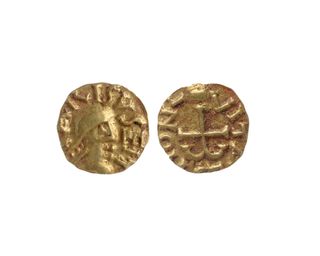
Though almost all of the Anglo-Saxon prince's body had long since decayed, archaeologists believe that he may have been buried clutching one of these gold coins in each hand. The coins were found inside the remnants of the man's wooden coffin, positioned where his hands likely would have been.
Foil Crosses
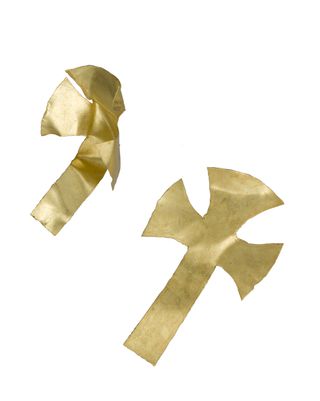
Two thin, gold-foil crosses were found at the head of the coffin. Archaeologists believe the objects may have been placed over the dead man's eyes. These artifacts show that the man was a Christian, making this the earliest Anglo-Saxon Christian burial site ever discovered. There is no way to tell who the man was, though archaeologists speculate that he could have been a relative of the Christian Anglo-Saxon King Saebert, who died in A.D. 616.
Wall Hooks
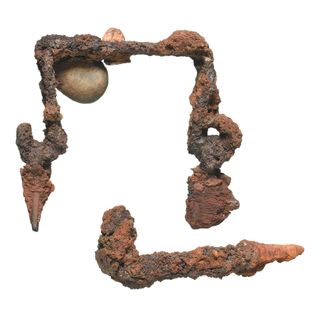
Wall hooks were used to hang bowls, vessels and possibly textiles on the chamber's walls. These iron hooks turned out to be very valuable for archaeologists because bits of mineral-preserved wood clung to them (the chamber walls had long since decayed). These fragments enabled researchers to virtually reconstruct the timbers used to build the chamber.
Tiny Treasure
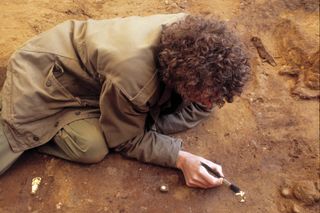
MOLA archaeologist Ian Blair brushes dirt from one of the gold-foil crosses that probably covered the dead Anglo-Saxon's eyes. The triangular belt buckle can be seen near Blair's knee. Based on the positioning of these and other clothing fasteners, researchers estimate that the deceased was 5 feet, 8 inches (1.73 meters) tall.
Uncovering Cups
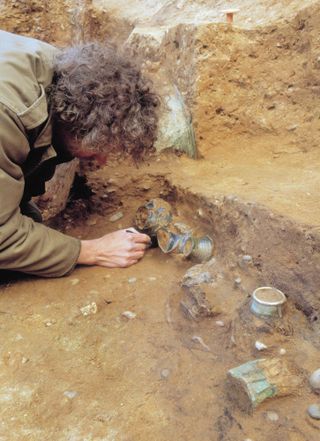
Archaeologist Ian Blair excavates 1,400-year-old drinking vessels in 2003, shortly after the original discovery of the Prittlewell site. The site was first found during an archaeology survey performed before a road-widening project.
Analysis in the Lab
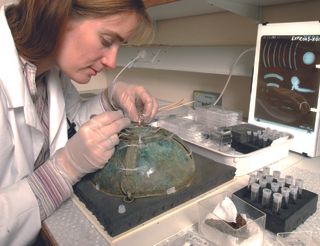
Museum of London Archaeology conservator Liz Barham examines the copper-alloy bowl discovered hanging on the rotted-away remnants of the burial chamber wall.
Blue Beaker
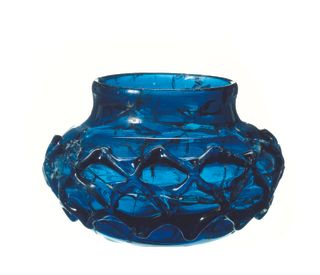
Archaeologists found two blue glass beakers in the chamber, a rare find from this era. The matching vessels were intact and positioned near the coffin.
Sign up for the Live Science daily newsletter now
Get the world’s most fascinating discoveries delivered straight to your inbox.
Bits of a Lyre
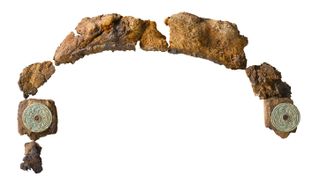
A close-up of the metal remnants of a lyre placed in the burial chamber. The garnet seen at the left came from India; the fittings surrounding it are made of copper alloy. These fittings would have attached the body of the lyre to the yoke at the top, across which the strings stretched.
Painted Wood
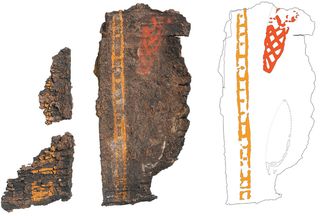
Incredibly fragile, these bits of painted wood once formed part of a decorated box that held a silver spoon from the Mediterranean. This is the only surviving example of early Anglo-Saxon painted woodwork, according to MOLA. The maple lid of the box was painted with red and yellow ochre, and white pigments derived from the mineral gypsum. The yellow border pattern matches similar patterns seen on Anglo-Saxon jewelry; the red ovals may be fish.
A Princely Resting Place

A virtual reconstruction of a 1,400-year-old Anglo-Saxon tomb discovered near Prittlewell, Essex, in 2003. The tomb once held the remains of an adolescent or adult Christian man of aristocratic lineage. The painstaking excavation of the burial chamber revealed gold ornaments and goods from as far away as India and the Mediterranean.
[Read More About the Earliest Known Christian Burial in England]
Green Glass
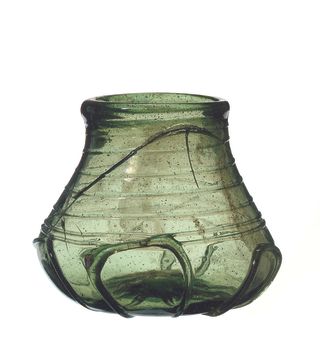
A green glass beaker found in the burial chamber. Among the goods buried with the deceased were flagons, cups and other eating implements. Archaeologists even found the remnants of a large hunk of beef, perhaps left as a feast for the afterlife. The artifacts found in the burial mound and grave are typical of items from the pre-Christian culture that once prevailed in what is now England, though gold crosses found in the tomb indicate that the deceased was a Christian.

Stephanie Pappas is a contributing writer for Live Science, covering topics ranging from geoscience to archaeology to the human brain and behavior. She was previously a senior writer for Live Science but is now a freelancer based in Denver, Colorado, and regularly contributes to Scientific American and The Monitor, the monthly magazine of the American Psychological Association. Stephanie received a bachelor's degree in psychology from the University of South Carolina and a graduate certificate in science communication from the University of California, Santa Cruz.
Most Popular

